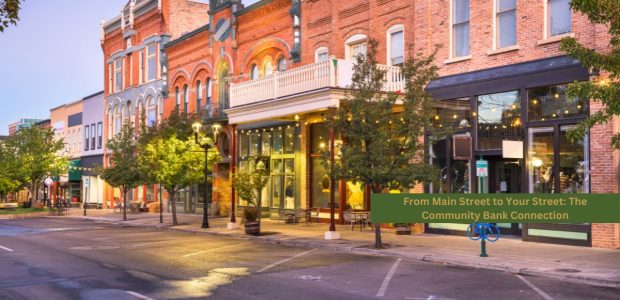Established in 1913 and family-owned since 1930, Flanagan State Bank has been a testament to the belief in one family helping another. But what exactly is the role of a bank in the community? How do local banks foster growth, stability, and support for their members?
In this post, we’ll look at the many ways local banks can serve and support their surrounding communities, making them safer, stronger, and more prosperous places to live, learn, and raise a family.

What is a bank’s role in the community?
At one time, banks acted as a physical center for commerce and personal financial management in towns across the country. Regular visits to a branch were necessary for most individuals and businesses, from depositing paychecks to borrowing for major purchases. As the core functions of banking have increasingly shifted to digital, the role of banks in communities has changed as well.
However, as the Federal Reserve discusses in their report, “Perspectives from Main Street: Bank Branch Access in Rural Communities,” not only do local banks “continue to be an important banking channel for consumers” for making deposits and resolving account issues, but small businesses count on their local banks to fund their growth and help them manage their day-to-day finances, too. As they explain, “the majority of small businesses prefer to utilize local banks to access financial services and may garner tangible benefits from doing so in terms of credit availability and the terms of that credit.”
While branch visits may decrease, banks are still vital in the community. Regional banks offer location-based, specialized expertise and lending flexibility only local partners can.
Financial Stability and Security
Community banks are the guardians of a community’s wealth, ensuring the safekeeping of community members’ hard-earned money and providing a sense of security and trust. By offering a structured financial system, banks lay the foundation for a stable local economy, ensuring that funds are available when needed—and safeguarded when not.
While the popularity of online banking has risen in recent years, bank branches are still essential in providing access to funds and services. They are still the most widely used way for individuals to access their bank accounts, with nearly three-quarters of banked households in the United States using a bank teller to access an account in the past year.
Economic Growth
Banks are more than just money holders; they are catalysts for community growth. Local banks facilitate commerce, providing essential banking services that keep the economic wheels turning. And better than anyone else, local banks can turn community-member deposits into affordable loans for others, keeping funds local. These funds can be used to:
- Stimulate business activities, allowing entrepreneurs to bring their visions to life.
- Build wealth and stability by helping families purchase homes.
- Fund improvements, from new largescale building projects to smaller home renovations, make neighborhoods a more desirable place to live.

Employment Opportunities
Banks are significant employers in the community. In fact, as the American Banking Association points out, “America’s banks employ more than 2 million women and men in a range of rewarding careers, from cybersecurity, fintech, and marketing to lending, compliance, and community development.”
In Illinois alone, financial service employees, including financial managers, loan officers, bank specialists, and other financial jobs, provide employment for over 60,000 individuals. Like many others, Flanagan State Bank offers many career growth and development opportunities, ensuring the community’s workforce remains robust and skilled.
In addition to providing jobs, community banks can help businesses create new jobs by providing the funding necessary to startup, hire employees, and grow.
Other Ways Banks Help the Community
Community banking doesn’t just provide the necessary financial services communities need to thrive. Because of their commitment to the places they serve, local banks strive to give back through many channels, from employee volunteering to donations and educational initiatives.
Community Development Projects
Banks often work behind the scenes, funding local infrastructure projects that enhance the quality of life. From parks to roads, their contributions are everywhere, and municipalities and organizations often turn first to community banks for their flexibility and willingness to go the extra mile.
Local banks are also avid supporters of charitable causes and nonprofits, ensuring that the community’s welfare is always a priority. In 2022, the community banks in Illinois gave 596.7 volunteer hours and $161.9 million dollars in community donations. At Flanagan State Bank, our charitable donations have helped sponsor everything from smart boards at Roanoke-Benson Junior High School to improved vocational facilities for students at El Paso-Gridley Centennial campus.
Financial Literacy Programs
Banks play a pivotal role in empowering the community through financial literacy. By organizing workshops and seminars, they educate both the youth and adults about money management, ensuring a financially savvy future generation.
In addition to the financial insights provided through our blog, Flanagan State Bank offers financial literacy lesson plans for grades K-12, College, and Special Needs.

Ways Banks Support Various Community Segments
Each small town comprises various segments that all work together to form a viable community. Banks support members and organizations at all levels.
Business Owners
Banks offer a range of services, from business loans to advisory services and financial planning, ensuring that businesses have the resources they need. They also facilitate international trade, offering forex services that bridge local businesses to global markets.
Community Members
For the everyday individual, banks don’t just offer a safe place to store and access their money. They also offer personal loans, mortgages, safe deposit boxes, and wealth management services. As one of the most crucial community-building services banks offer, Illinois banks provided 220,789 new home loans in 2020, totaling $55.9 billion.
Local financial institutions also make special savings programs and retirement planning available and accessible, ensuring that every stage of life is financially secure.

Schools
Education is the bedrock of any community, and banks are its staunch supporters. Beyond offering affordable financing for improvements and building projects, local banks fund educational programs and collaborate for financial literacy initiatives, ensuring that local children can enjoy a brighter future.
The above-mentioned donations to area schools are just the tip of the iceberg for us at Flanagan State. Our donations have helped to fund new playground spaces, agricultural classrooms, school athletic facilities, desks and chairs for teachers and students, and performing arts facilities from Bloomington to LeRoy.
Flanagan State Bank is Dedicated to Serving and Supporting Our Local Community
From Flanagan to Pontiac and every town in between, Flanagan State Bank has been a beacon of trust, support, and growth since 1913. Our commitment to the community is unwavering, with services tailored to meet the diverse needs of every community segment.
Whether you’re a business owner in Pontiac, a student in Benson, or a family in Gridley, our dedicated team at Flanagan State Bank is here to assist, ensuring that from Main Street to your street, you’re always in good hands.
Reach out to speak to one of our bankers or visit a nearby community bank branch.






